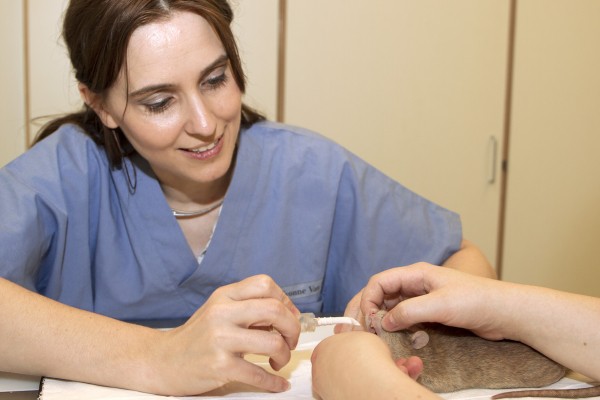3Rs Stimulus Fund: refining anesthesia
8 years agoYvonne van Zeeland, a specialist in avian medicine from the Division of Zoological Medicine of Utrecht University’s Clinic for Companion Animals, and her colleagues were awarded a grant from the 3Rs Stimulus Fund for their research proposal “Refining anaesthesia procedures for guinea pigs, rats and mice through the use of species-specific supraglottic airway devices”. This could be a breakthrough in refining animal experiments in which anaesthesia is applied.
What do you aim to accomplish with this research?
Our research group is hoping to refine the techniques used for anaesthetising animals, both patients and laboratory animals. Some of these techniques may cause discomfort to the animal. When intubating an animal, a relatively rigid silicone tube is inserted into the trachea in between the vocal cords. People who have been intubated often experience a sore throat afterwards, so it’s likely that this occurs in animals too. There can also be complications like spasms of the vocal cords, bleeding, swelling or formation of scars and strictures. For people, a good alternative has been developed, a so-called laryngeal mask or supraglottic airway device. This device is much softer and is positioned over the larynx, so that it does not have to pass through the vocal cords. We’re now developing these airway devices for different animal species, and adjusting them to the anatomy of the throat area of the species, which is essential for the device to function properly.
How did you end up doing this research?
A company that developed the device for people also wanted to have these devices developed for animals. In 2009 they approached us to see if we were interested in collaborating with them in the design process. The initial devices that were developed were predominantly designed for species commonly seen in the veterinary practice: dogs, cats, horses, and rabbits, which my colleagues and I were happy to work on. After all, we are veterinarians and want to provide animals the best possible care.
But this project involves small rodents.
At some point we said, hey, let’s look at laboratory animals. There may not be too much surgery performed on pet rodents in veterinary practices, but it’s quite common in animal experiments. We want lab animals to have similar welfare benefits as pets. In our studies, we have seen that supraglottic airway devices can be inserted easily and quickly without causing damage to the airway. This results in shortening of the anaesthetic procedure, and minimizes the discomfort experienced by the animal when it wakes up. Now that’s refinement. There’s also a lower risk of serious complications, which reduces drop-out, so that fewer animals are needed. We’re now conducting the research in cooperation with the Central Laboratory Animal Research Facility of Utrecht University and the UMC Utrecht.
You also need laboratory animals for this research itself. How do you deal with that?
Indeed, we wanted to work in as animal-friendly a way as we could, and it helped to work with other groups. We made our first designs for the masks using dead animals that were plastinated in the Pathobiology department. Once we were satisfied with the first prototypes, we fit them on cadavers. Often we had to make some minor adaptations to refine the masks even more before going on to test them on live animals. We found groups doing experiments that already called for the animals to be put under anaesthesia and not reawakened, so that additional discomfort wouldn’t be an issue, and we wouldn’t need any extra animals. We’ve done this with researchers from the University Medical Center Utrecht, the VU University Medical Center and the Academic Medical Center.
And now?
We’ve now successfully tested the devices on guinea pigs and rats, and we’ve come a long way with mice. We’re about to start a study comparing ease of use, functionality and safety of the devices with the current methods, endotracheal intubation and face masks. We’ll compare the time needed to intubate versus placing the device, the quality of the anaesthesia, the level of fit and presence of leakage, and the presence and severity of tissue damage. Similar to the initial studies, we will again be trying to fit our research into existing experiments so that we need as few extra animals as possible.
Are you hopeful about the results?
Definitely! So far, the animals on which we have used the devices recovered quickly and smoothly from anaesthesia, and researchers have even performed successful open-chest surgeries on guinea pigs using the devices. Nevertheless we have to wait for the results of the comparative studies to prove that the mask performs better in all areas. We hope to have these experiments rounded off before the end of the year for at least the guinea pigs, and hopefully also for the rats. If the results are positive, I expect that the masks will be brought to the market within a year. And since pigs are used quite a lot for experiments as well, there are also plans to start developing a supraglottic airway device for this species.
Why was funding by the 3Rs Stimulus Fund necessary for this research?
The grant enables us to perform the comparative studies, which are essential to prove scientifically that the supraglottic airway device does what it is supposed to do, and that it’s better than the current methods. In principle, the manufacturer doesn’t need this research to launch the product. Strangely enough, the strict registration procedure required for drugs is not applicable to medical devices. But the company is committed, and wants animals to really profit from its products. And as researchers we want to demonstrate that the devices we have developed perform better than the current methods. The funding we have obtained from the 3Rs Stimulus Fund enables us to obtain the scientific evidence to support this claim.
The 3Rs Stimulus Fund is a fund of University Utrecht and the UMC Utrecht for employees’ research initiatives aimed at Replacement, Reduction and Refinement of animal experiments.


